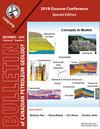多尺度综合地质储层建模的三种地质统计技术综述
Q3 Earth and Planetary Sciences
引用次数: 7
摘要
本文讨论了为生成地质模型而开发的新方法和工作流程(1),这些模型在地质学上看起来更真实,(2)尊重表征研究区域的井和地震数据。同时考虑这两个约束是具有挑战性的,因为它们的行为方式相反。地质模型越真实,数据的整合难度越大。第一种有效的方法是基于非平稳多高斯模拟方法。在这种情况下,可用的地质和地震数据使计算相比例的三维概率分布成为可能,然后用于截断高斯函数。第二种方法是基于贝叶斯序列模拟。最近的发展建议将这种方法扩展到包括不同相的介质。我们提出了一种改进的变体,以更好地解释声波测井和地震数据之间的分辨率差异。这产生了一个更强大的框架来整合地震数据。第三种创新方法将地质统计多点模拟与纹理合成原理相结合。地质统计多点方法提供了更好地再现复杂地质特征的模型。然而,它们仍然需要大量的计算时间。另一方面,纹理合成已经发展为计算机图形学:它可以帮助减少计算时间,但它不考虑数据。然后,我们设想了一种混合多尺度算法,它具有改进的计算性能,但能够尊重数据本文章由计算机程序翻译,如有差异,请以英文原文为准。
A Review of Three Geostatistical Techniques for Realistic Geological Reservoir Modeling Integrating Multi-scale Data
Abstract This paper discusses new methodologies and workflows developed to generate geological models (1) that look more realistic geologically speaking and (2) that respect the well and seismic data characterizing the studied area. Accounting simultaneously for these two constraints is challenging as they behave the opposite way. The more realistic the geological model, the more difficult the integration of data. A first powerful approach is based upon the non-stationary plurigaussian simulation method. In this case, the available geological and seismic data make it possible to compute the 3D probability distributions of facies proportions, which are then used to truncate the Gaussian functions. A second method is rooted in the Bayesian sequential simulation. Recent developments have been proposed to extend this method to media including distinct facies. We suggest an improved variant to better account for the resolution differences between sonic logs and seismic data. This yields a more robust framework to integrate seismic data. A third innovative approach reconciles geostatistical multipoint simulation with texture synthesis principles. Geostatistical multipoint methods provide models, which better reproduce complex geological features. However, they still call for significant computation times. On the other hand, texture synthesis has been developed for computer graphics: it can help reduce computation time, but it does not account for data. We then envision a hybrid multi-scale algorithm with improved computation performances and yet able to respect data
求助全文
通过发布文献求助,成功后即可免费获取论文全文。
去求助
来源期刊

Bullentin of Canadian Petroleum Geology
Earth and Planetary Sciences-Geochemistry and Petrology
CiteScore
2.50
自引率
0.00%
发文量
0
期刊介绍:
The Bulletin of Canadian Petroleum Geology is a peer-reviewed scientific journal published four times a year. Founded in 1953, the BCPG aims to be the journal of record for papers dealing with all aspects of petroleum geology, broadly conceived, with a particularly (though not exclusively) Canadian focus. International submissions are encouraged, especially where a connection can be made to Canadian examples.
 求助内容:
求助内容: 应助结果提醒方式:
应助结果提醒方式:


